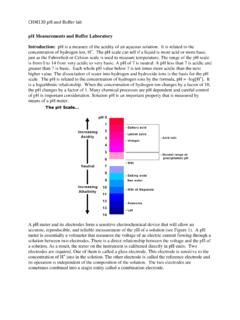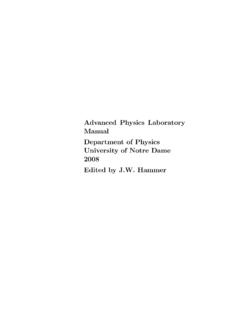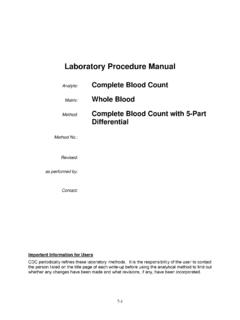Transcription of 12 LABORATORY SAMPLE PREPARATION - epa.gov
1 12 LABORATORY SAMPLE PREPARATION . Introduction On first impression, SAMPLE PREPARATION may seem the most routine aspect of an analytical protocol. However, it is critical that analysts realize and remember that a measurement is only as good as the SAMPLE PREPARATION that has preceded it. If an aliquant taken for analysis does not represent the original SAMPLE accurately, the results of this analysis are questionable. As a general rule, the error in sampling and the SAMPLE PREPARATION portion of an analytical procedure is considerably higher than that in the methodology itself, as illustrated in Figure Sampling SAMPLE PREPARATION Concentration, Separation, Isolation, etc. Steps Measurement (After Scwedt, 1997). FIGURE Degree of error in LABORATORY SAMPLE PREPARATION relative to other activities One goal of LABORATORY SAMPLE PREPARATION is to provide, without SAMPLE loss, representative aliquants that are free of LABORATORY contamination that will be used in the next steps of the protocol.
2 Samples are prepared in accordance with applicable standard operating procedures (SOPs) and LABORATORY SOPs using information provided by field SAMPLE PREPARATION (Chapter 10, Field and Sampling Issues that Affect LABORATORY Measurements), SAMPLE screening activities, and objectives given in the appropriate planning documents. The LABORATORY SAMPLE PREPARATION techniques presented in this chapter include the Contents physical manipulation of the SAMPLE (heating, screening, grinding, mixing, etc.) up to the Introduction .. 12-1. point of dissolution. Steps such as adding General Guidance for SAMPLE PREPARATION .. 12-2. carriers and tracers, followed by wet ashing or Solid Samples .. 12-12. fusion, are discussed in Chapter 13 ( SAMPLE Filters .. 12-30. Wipe Samples .. 12-31. Dissolution) and Chapter 14 (Separation Liquid Samples.)
3 12-32. Techniques). Gases .. 12-36. Bioassay .. 12-36. This chapter presents some general guidance References .. 12-37. JULY 2004 12-1 MARLAP. LABORATORY SAMPLE PREPARATION for SAMPLE PREPARATION to avoid SAMPLE loss and SAMPLE contamination. Due to the physical nature of the matrix, SAMPLE PREPARATION for solids requires the most attention, and therefore is discussed at great length (Section ). General procedures for preparing solid samples (such as drying, obtaining a constant weight, grinding, sieving, mixing, and subsampling) are discussed. Some SAMPLE PREPARATION procedures then are presented for typical types of solid samples ( , soil and sediment, biota, food, etc.). This chapter concludes with specific guidance for preparing samples of filters (Section ), wipes (Section ), liquids (Section ), gases (Section ), and bioassay (Section ).
4 General Guidance for SAMPLE PREPARATION Some general considerations during SAMPLE PREPARATION are to minimize SAMPLE losses and to prevent contamination. Possible mechanisms for SAMPLE loss during PREPARATION steps are discussed in Section , and the contamination of samples from sources in the LABORATORY is discussed in Section Control of contamination through cleaning labware is important and described in Section , and LABORATORY contamination control is discussed in Section Potential SAMPLE Losses During PREPARATION Materials may be lost from a SAMPLE during LABORATORY PREPARATION . The following sections discuss the potential types of losses and the methods used to control them. The addition of tracers or carriers (Section ) is encouraged at the earliest possible point and prior to any SAMPLE PREPARATION step where there might be a loss of analyte.
5 Such PREPARATION steps may include homogenization or SAMPLE heating. The addition of tracers or carriers prior to these steps helps to account for any analyte loss during SAMPLE PREPARATION . Losses as Dust or Particulates When a SAMPLE is dry ashed, a fine residue (ash) is often formed. The small particles in the residue are resuspended readily by any air flow over the SAMPLE . Air flows are generated by changes in temperature ( , opening the furnace while it is hot) or by passing a stream of gas over the SAMPLE during heating to assist in combustion. These losses are minimized by ashing samples at as low a temperature as possible, gradually increasing and decreasing the temperature during the ashing process, using a slow gas-flow rate, and never opening the door of a hot furnace (Section ). If single samples are heated in a tube furnace with a flow of gas over the SAMPLE , a plug of glass or quartz wool can be used to collect particulates or an absorption vessel can be used to collect volatile materials.
6 At a minimum, all ash or finely ground samples should be covered before they are moved. Solid samples are often ground to a fine particle size before they are fused or wet ashed to increase the surface area and speed up the reaction between the SAMPLE and the fluxing agent or MARLAP 12-2 JULY 2004. LABORATORY SAMPLE PREPARATION acid (see Chapters 13 and 14 on dissolution and separation). Since solid samples are frequently heterogeneous, a source of error arises from the difference in hardness among the SAMPLE components. The softer materials are converted to smaller particles more rapidly than the harder ones, and therefore, any loss in the form of dust during the grinding process will alter the composition of the SAMPLE . The finely ground particles are also susceptible to resuspension. Samples may be moistened carefully with a small amount of water before adding other reagents.
7 Reagents should be added slowly to prevent losses as spray due to reactions between the SAMPLE and the reagents. Losses Through Volatilization Some radionuclides are volatile under specific conditions ( , heat, grinding, strong oxidizers), and care should be taken to identify samples requiring analysis for these radionuclides. Special PREPARATION procedures should be used to prevent the volatilization of the radionuclide of interest. The loss of volatile elements during heating is minimized by heating without exceeding the boiling point of the volatile compound. Ashing aids can reduce losses by converting the SAMPLE into less volatile compounds. These reduce losses but can contaminate samples. During the wet ashing process, losses of volatile elements can be minimized by using a reflux condenser. If the solution needs to be evaporated, the reflux solution can be collected separately.
8 Volatilization losses can be prevented when reactions are carried out in a properly constructed sealed vessel. Table lists some commonly analyzed radioisotopes, their volatile chemical form, and the boiling point of that species at standard pressure. Note that the boiling point may vary depending upon solution, matrix, etc. Often the moisture content, and thus, the chemical composition of a solid is altered during grinding and crushing (Dean, 1995). Decreases in water content are sometimes observed while grinding solids containing essential water in the form of hydrates, likely as a result of localized heating. (See Section for a discussion of the types of moisture present in solid samples.). Moisture loss is also observed when samples containing occluded water are ground and crushed. The process ruptures some of the cavities, and exposes the water to evaporation.
9 More com- monly, the grinding process results in an increase in moisture content due to an increase in surface area available for absorption of atmospheric water. Both of these conditions will affect the analysis of 3H since 3H is normally present in environmental samples as 3 HOH. Analysis for tritium in soils should avoid these types of SAMPLE PREPARATION prior to analysis. Instead, total water content should be determined separately. Tritium analysis then could be performed by adding tritium-free ( dead ) water to an original SAMPLE aliquant followed by filtration or distillation. JULY 2004 12-3 MARLAP. LABORATORY SAMPLE PREPARATION TABLE Examples of volatile radionuclides Isotope Chemical Form Boiling Point (EC) *. 3. Tritium H H2O 100E. CO2 (produced from CO3-2 or Carbon 14C oxidation of organic material).
10 Natural ores of these metals decompose Magnesium, calcium, and sodium between 825E and 1,330E to yield the carbonates respective metal oxides Iodine 131I, 129I I2 (sublimes readily). Cs0 (as metal) (melts at 28). 134 135. Cesium Cs, Cs, Cs2O (as metallic oxide) ~400E. 136. Cs, 137Cs (nitrates decompose to oxides). CsCl (as metallic chloride) 1290E. Tc2O7 TcCl4 Sublimes above 300E. Technetium 99Tc TcO2 Sublimes above 900E. [Most Tc compounds sublime above 300E. Tc(VII) is an oxidant that reacts with organic solvents forming Tc(IV)]. Po0 962E. 208 209. Polonium Po, Po, PoCl4 390E. 210. Po Po(NO3)4 [as a solid] Decomposes to PoO2 above ~150E. PoO2 Decomposes to Po metal above 500E. Pb0 1744E. 210 212 205 PbCl2 950E. Lead Pb, Pb, Pb Pb(NO3)2 Decomposes to oxide above 470E. PbO 888E. * The closer the SAMPLE PREPARATION temperature is to the boiling point of the compound, the more significant will be the loss of the material.















